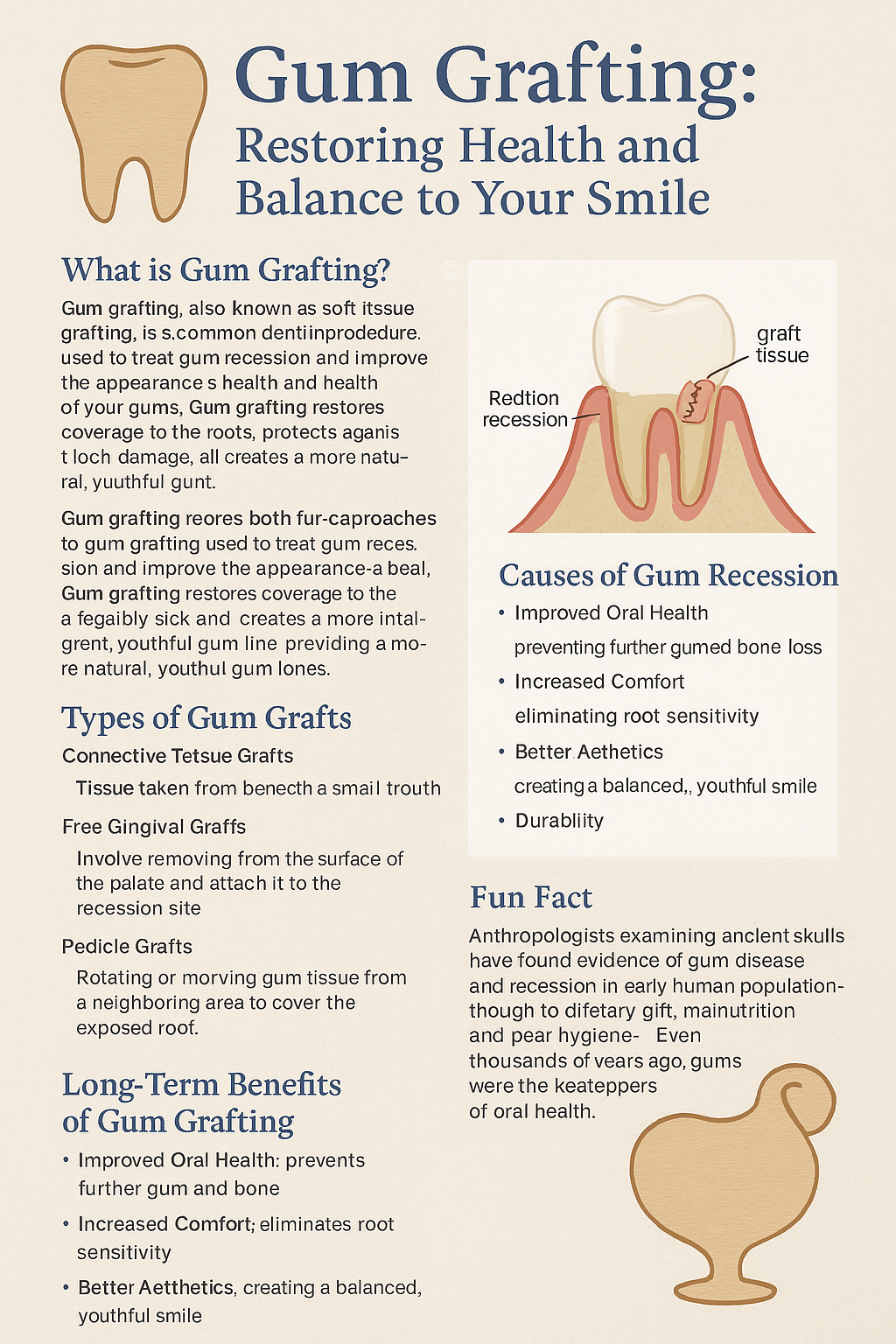
What is Gum Grafting?
Gum grafting, also called soft tissue grafting, is a common dental procedure used to treat gum recession and improve the appearance and health of your gums. Gum recession can occur due to a variety of reasons: periodontal (gum) disease, aggressive brushing, genetics, trauma, or even teeth grinding.
When the gums recede, the roots of the teeth become exposed. This can cause:
- Increased tooth sensitivity to hot, cold, or acidic foods.
- Teeth that look “longer” than normal.
- Greater risk of root decay and wear.
- If left untreated, continued gum loss that may lead to tooth mobility or even tooth loss.
Gum grafting restores coverage to the roots, protects against further damage, and creates a more natural, youthful gum line.
Types of Gum Grafts
There are several approaches to gum grafting, and your dentist or periodontist will recommend the one best suited to your needs:
- Connective Tissue Grafts – The most common type. Tissue is taken from beneath a small flap in the roof of the mouth and grafted to the affected area.
- Free Gingival Grafts – Tissue is directly removed from the surface of the palate and attached to the recession site.
- Pedicle Grafts – Gum tissue is rotated or moved from a neighboring area to cover the exposed root.
Each method has the same goal: to rebuild healthy gum tissue where it’s needed most.
Why Are Gum Grafts Performed?
Gum grafts serve both functional and cosmetic purposes:
- Stop Further Gum Recession – Protects the tooth root and supporting bone.
- Reduce Sensitivity – Exposed roots can feel sharp pain with hot, cold, or sweet foods; grafts restore comfort.
- Protect Roots from Decay – Unlike enamel, roots are softer and prone to cavities when exposed.
- Enhance Aesthetics – Recession can create an uneven gum line or “long teeth.” Grafts restore symmetry and balance to the smile.
Causes of Gum Recession
Understanding what causes gum recession can help prevent future problems:
- Periodontal (gum) disease
- Aggressive brushing with a hard toothbrush
- Poor oral hygiene leading to plaque and tartar buildup
- Tobacco use
- Genetics (some individuals are simply more prone)
- Teeth grinding or clenching
Addressing these underlying causes is just as important as performing the graft.
What to Expect During and After the Procedure
Gum grafting is performed under local anesthesia, with sedation available if desired. The procedure is usually completed in one appointment.
During treatment:
- The donor tissue (either your own or processed donor tissue) is carefully secured over the exposed root.
- The graft integrates with the existing gum, gradually forming a stronger protective layer.
After treatment:
- Mild swelling or discomfort is common for a few days.
- A soft food diet (yogurt, soup, eggs, mashed potatoes) helps protect the site during healing.
- Avoid brushing directly on the grafted area until cleared by your dentist.
- Detailed post-op instructions are provided to ensure smooth healing.
Within a few weeks, the graft blends naturally with your gums, restoring both function and appearance.
Long-Term Benefits of Gum Grafting
The advantages of gum grafting go beyond the immediate relief of sensitivity:
- Improved Oral Health – Prevents further gum and bone loss.
- Increased Comfort – Eliminates root sensitivity.
- Better Aesthetics – Creates a balanced, youthful smile.
- Durability – Once risk factors are controlled, grafts can last for decades.
A Glimpse into History
Did you know that gum grafting has its origins in early periodontal research from the mid-20th century? Early pioneers experimented with autogenous tissue grafts (using the patient’s own tissue) to cover recession defects. By the 1980s and 1990s, refined microsurgical techniques made gum grafting more predictable and less invasive.
Today, innovations like acellular dermal matrices (processed donor tissue) mean grafting can be done without harvesting tissue from the patient’s palate in certain cases — reducing discomfort while achieving excellent results.
Fun Fact
Gum recession isn’t just a modern issue. Anthropologists examining ancient skulls have found evidence of gum disease and recession in early human populations — though their causes were often more linked to dietary grit, malnutrition, and poor hygiene. Even thousands of years ago, gums were the gatekeepers of oral health!
FAQs About Gum Grafting
1. Is gum grafting painful?
No. The procedure is performed under local anesthesia, and most patients report only mild soreness afterward.
2. How long does it take to heal?
Initial healing takes about 1–2 weeks, but full integration can take several months.
3. Will the graft look natural?
Yes. Over time, grafted tissue blends seamlessly with your existing gums.
4. Do gum grafts always use tissue from the palate?
Not always. Donor tissue or grafting materials can also be used, depending on your case.
5. How do I prevent future gum recession?
Use a soft-bristled toothbrush, avoid aggressive brushing, maintain excellent oral hygiene, quit smoking, and manage grinding or clenching.
Final Thoughts
If your teeth look longer than before or you notice sensitivity near the gum line, don’t ignore the signs. Gum grafting is a proactive solution that restores gum health, protects teeth, and enhances your smile’s appearance.

